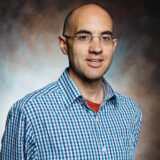Justin Corvino

Degrees
- Ph.D. (mathematics): Stanford University
- M.S. (mathematics): Stanford University
- B.S. (mathematics, minor in physics): Massachusetts Institute of Technology
My Love of Teaching
I have discovered profound satisfaction in working with students and advisees who have differing relationships with math.
It’s not just working with the high flyers, but also with someone who’s struggling or thinks they’re struggling, but works hard and asks questions, from 100-level introductory courses to advanced topics. I always try to be available and approachable for the students who are putting in the effort, and to be a thoughtful and supportive adviser.
The common denominator in all of my classes is that students need to be ready to work hard. And I’m ready to meet them halfway. The students who learn the most are the ones who engage with me outside of class and challenge themselves. That faculty-student relationship is a Lafayette hallmark.
My Research Interests
I work in an area of mathematics called differential geometry, which brings the tools of calculus to bear on geometric problems. Think about a surface sitting in space: Calculus allows you to compute the curvature of the surface and frame questions about it. While differential geometry brings in calculus and differential equations to geometry, it also can be applied in different areas, from materials engineering to theoretical physics.
I’ve enjoyed math since I was a kid. For a while it was second to baseball: I’d always be waiting with two well-worn mitts and a scuffed-up ball for when my dad would get home from work. While on drives, he often asked me to add up long lists of accounts receivable in my head, but I’m not sure that can account for my love of math. After my mom successfully advocated for me to take algebra and geometry concurrently, she ended up having to teach me how to factor polynomials using her old high school notebook. That was so cool!
I can safely say my parents could never have known I’d be spending lots of my time studying differential equations having to do with curvature, or that a lot of the problems I’ve studied are distilled from mathematical physics and general relativity, Einstein’s theory of gravitation. My research sheds light on the variety of solutions to Einstein’s gravitational equations, the study of which adds to our current understanding of models of the universe and the behavior of isolated gravitational systems.
Why Lafayette?
Whether or not I realized it, I’ve had a homing beacon on Lafayette ever since my days growing up in Martin’s Creek and attending Easton Area High School, when I came to campus to take multivariable calculus with mathematics professor Evan Fisher, now my colleague. As fate would have it, I serendipitously noticed flyers in Pardee Hall advertising an advanced topics course in differential geometry, which I took alongside a small handful of Lafayette students, maybe some of whom were not so unlike some of my eventual honors thesis students.
A member of my high school debate team, I spent considerable time at Skillman Library preparing for competitions. I also spent many hours hitting on Lafayette’s tennis courts (my favorites were the old ones that were across from Kirby) with teammates from the Easton High tennis team. On weekends, my dad took me to Lafayette football games at Fisher Field, where I’d also gather with my classmates for the annual Thanksgiving Day Easton-Phillipsburg game. My dad actually started out working as an accountant in the Alpha Building in downtown Easton, now home to several Lafayette departments.
After graduate school, I received a National Science Foundation Postdoctoral Research Fellowship and served as a Tamarkin Assistant Professor of Mathematics at Brown University for four years. When a position in the Math Department opened at Lafayette, I jumped at the opportunity to return to a very familiar and comfortable place. I’ve been a more permanent part of the campus since 2004.
It was like coming home, in terms of being close to my family and returning to Pardee Hall. All the times on campus as a kid I felt like an outsider, so I’ve enjoyed the sense of belonging.
Personal Interests/Community Work
I am the regional chair of MIT’s Educational Council, an alumni organization that coordinates interviews with applicants for admission to MIT. I’m also an avid cyclist, and until my rotator cuff tear is mended, I’m enjoying tennis vicariously as mentor for the College’s tennis teams.